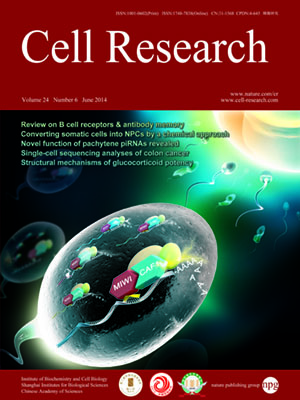
Volume 24, No 6, Jun 2014
ISSN: 1001-0602
EISSN: 1748-7838 2018
impact factor 17.848*
(Clarivate Analytics, 2019)
Volume 24 Issue 6, June 2014: 713-726
ORIGINAL ARTICLES
Structures and mechanism for the design of highly potent glucocorticoids
Yuanzheng He1, Wei Yi2, Kelly Suino-Powell1, X Edward Zhou1, W David Tolbert1, Xiaobo Tang2, Jing Yang3, Huaiyu Yang3, Jingjing Shi2, Li Hou2, Hualiang Jiang3, Karsten Melcher1 and H Eric Xu1,2
1Laboratory of Structural Sciences, Van Andel Research Institute, Grand Rapids, MI 49503, USA
2VARI-SIMM Center, Center for Structure and Function of Drug Targets, Key Laboratory of Receptor Research, Shanghai Institute of Materia Medica, Chinese Academy of Sciences, Shanghai 201203, China
3Center for Drug Discovery and Design, State Key Laboratory of Drug Research, Shanghai Institute of Materia Medica, Chinese Academy of Sciences, Shanghai 201203, China
Correspondence: H Eric Xu, Tel: +1-616-234-5772 E-mail: eric.xu@vai.org; Yuanzheng He, E-mail: ajian.he@vai.org; Wei Yi,(yiwei.simm@simm.ac.cn)
The evolution of glucocorticoid drugs was driven by the demand of lowering the unwanted side effects, while keeping the beneficial anti-inflammatory effects. Potency is an important aspect of this evolution as many undesirable side effects are associated with use of high-dose glucocorticoids. The side effects can be minimized by highly potent glucocorticoids that achieve the same treatment effects at lower doses. This demand propelled the continuous development of synthetic glucocorticoids with increased potencies, but the structural basis of their potencies is poorly understood. To determine the mechanisms underlying potency, we solved the X-ray structures of the glucocorticoid receptor (GR) ligand-binding domain (LBD) bound to its endogenous ligand, cortisol, which has relatively low potency, and a highly potent synthetic glucocorticoid, mometasone furoate (MF). The cortisol-bound GR LBD revealed that the flexibility of the C1-C2 single bond in the steroid A ring is primarily responsible for the low affinity of cortisol to GR. In contrast, we demonstrate that the very high potency of MF is achieved by its C-17α furoate group completely filling the ligand-binding pocket, thus providing additional anchor contacts for high-affinity binding. A single amino acid in the ligand-binding pocket, Q642, plays a discriminating role in ligand potency between MF and cortisol. Structure-based design led to synthesis of several novel glucocorticoids with much improved potency and efficacy. Together, these results reveal key structural mechanisms of glucocorticoid potency and provide a rational basis for developing novel highly potent glucocorticoids.
10.1038/cr.2014.52
FULL TEXT | PDF
Browse 2323


